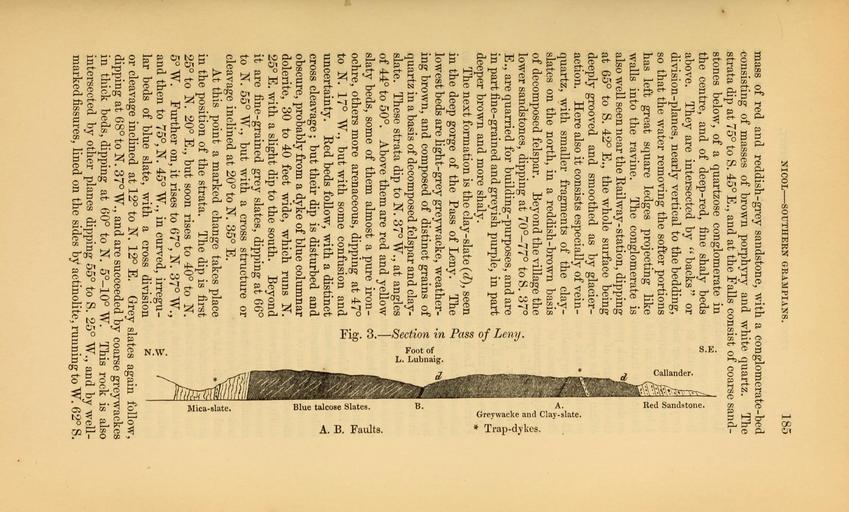MAKE A MEME
View Large Image

| View Original: | The_Quarterly_journal_of_the_Geological_Society_of_London_(12646203124).jpg (2032x1225) | |||
| Download: | Original | Medium | Small | Thumb |
| Courtesy of: | commons.wikimedia.org | More Like This | ||
| Keywords: The Quarterly journal of the Geological Society of London (12646203124).jpg NICOL SOUTHERN GRAMPIANS <br> 185 <br> to hai <br> mass of red and reddish-grey sandstone with a conglomerate-bed <br> consisting of masses of brown porphyry and white quartz The <br> strata dip at 75° to S 45° E and at the Falls consist of coarse sand- <br> stones below of a quartz ose conglomerate in <br> the centre and of deep-red fine shaly beds <br> above They are intersected by backs or <br> division-planes nearly vertical to the bedding <br> so that the water removing the softer portions <br> has left great square ledges projecting like <br> walls into the ravine The conglomerate is <br> also well seen near the Railway- station dipping <br> at 65° to S 42° E the whole surface being <br> deeply grooved and smoothed as by glacier- <br> action Here also it consists especially of vein- <br> quartz with smaller fragments of the clay- <br> slates on the north in a reddish-brown basis <br> of decomposed felspar Beyond the village the <br> lower sandstones dipping at 70°-77° to S 37° <br> E are quarried for building-purposes and are <br> in part fine-grained and greyish purple in part <br> deeper brown and more shaly <br> The next formation is the clay-slate d seen <br> in the deep gorge of the Pass of Leny The <br> lowest beds are light-grey greywacke weather- <br> ing brown and composed of distinct grains of <br> quartz in a basis of decomposed felspar and clay- <br> slate These strata dip to N 37° W at angles <br> of 44° to 50° Above them are red and yellow <br> slaty beds some of them almost a pure iron- <br> ochre others more arenaceous dipping at 47° <br> to N 17° W but with some confusion and <br> uncertainty Red beds follow with a distinct <br> cross cleavage ; but their dip is disturbed and <br> obscure probably from a dyke of blue columnar <br> dolerite 30 to 40 feet wide which runs N <br> 25° E with a slight dip to the south Beyond <br> it are fine-grained grey slates dipping at 66° <br> to N 55° W but with a cross structure or <br> cleavage inclined at 20° to N 35° E <br> At this point a marked change takes place <br> in the position of the strata The dip is first <br> 25° to N 20° E but soon rises to 40° to N <br> 5° W Further on it rises to 67° N 37° W <br> and then to 75° N 45° W in curved irregu- <br> lar beds of blue slate with a cross division <br> or cleavage inclined at 12° to N 12° E Grey slates again follow <br> dipping at 68° to N 37° W and are succeeded by coarse greywackes <br> in thick beds dipping at 60° to N 5°-10° W This rock is also <br> intersected by other planes dipping 55° to S 2h° W and by well- <br> marked fissures lined on the sides by actinolite running to W 62° S <br> 05 <br> I <br> CO <br> � i-H <br> �/; <br> -3 <br> J- <br> OS <br> V <br> '11 <br> ffl <br> o <br> <br> � <br> « <br> 2 <br> s 35328146 109632 51125 Page 185 Text v 19 http //www biodiversitylibrary org/page/35328146 1863 Geological Society of London Biodiversity Heritage Library The Quarterly journal of the Geological Society of London v 19 1863 Geology Periodicals Smithsonian Libraries bhl page 35328146 dc identifier http //biodiversitylibrary org/page/35328146 smithsonian libraries Information field Flickr posted date ISOdate 2014-02-20 Check categories 2015 August 26 CC-BY-2 0 BioDivLibrary https //flickr com/photos/61021753 N02/12646203124 2015-08-27 11 52 51 cc-by-2 0 PD-old-70-1923 The Quarterly journal of the Geological Society of London 1863 Photos uploaded from Flickr by Fæ using a script | ||||